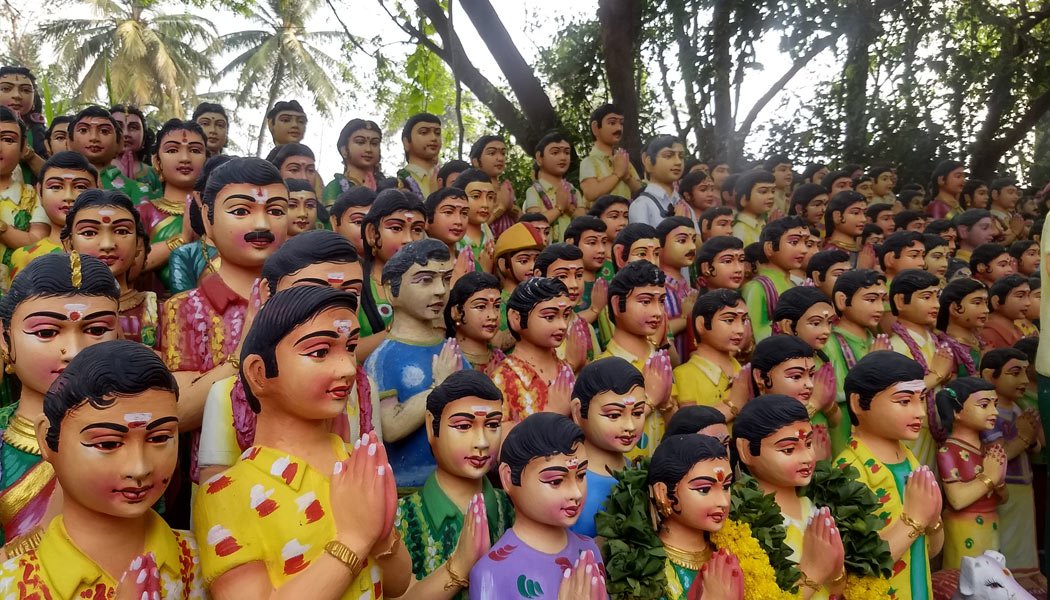When one interprets Bahour orgins – Temple inscriptions found in bahour main temple, melsevur, Tindivanam, Thiruvothur, Thiruvandheepuram, Thirupathiripuliyur and Kanchipuram‟s bronze plates are giving a clear peek into Bahour. Reign of Rashtrakuta – Krishna III, The Adhi Karikala – Raja Raja chozhan I, Rajendra chozhan, Rajendra chozhan II, Kulathunga Chozhan I, Vikrama Chozhan are linked the 21 inscriptions found in the 1000 year old temple of Moolanadhar – a Shivan temple. The inscriptions are found in ardhamandapadam of Shivan. It shows the inscriptions of Kanara Devaraya and Adhi Karikalan periods. It also has the inscriptions of pallavas and Parandhaga chozhan. The bronze plates mention a college, period of Nandi varman (858) Azhagiya Chozhan: Bahour is praised as Vakur by the Chozhans as a serene land – Azhagiya chozha chathurvedi mangalam. Vaagu interprets as beautiful in Thamizh. This serene land was of Sudhandhira Paranthagan. Father of Raja Raja I
Moolanathar swami temple: The Moolanathar swami temple was built in 940 by Parandhanga chozhan in dedication to lord shivan. It was built on the rules of the Kaarana aagaman., which means the structure is based on the proportions of the lying human body. The entrance resembles the feet and the shivalingam as the forehead. A specialty of Moolanathar swami temple is that its architecture is influenced from all the subsequent periods right upto the colonial period. It is under Archeological survey of India (ASI) protection but still open to worship. The ancient inscriptions on the temple walls are a rare archival source regarding community life, tank maintenance and the religious practices of ancient times.
Tank system: The tank system was built more than 1000 years ago under the rule of chozhans. A legend says that during a severe draught two unmarried, young and rich sisters – Bangari and Singari spent their whole wealth to building a canal from Pennaiyar river to Bahour tank. A stone carving remembers their greatness. Structure: the tank system in Bahour is fed by three main channels which branch off from the Pennaiyar river. It is separated into 3 clusters, consisting of 27 tanks in total. The tanks are connected like a chain where the water will overflow from one tank to the next lower tank. Within the system the water is stored and released to irrigate fields through a control system. The water is also used for social purposes – washing cattle, fish culture. The main function of the tanks is disaster prevention in the times of floods and droughts. In the wet period the tanks recharge the groundwater and the wells where the drinking water is sourced from. The wetland is also a dwelling place for many species of birds. During the dry period – the soil accumulated at the bottom of tanks are used for pottery, grazing ground cattle. Maintenance and problems: in the early times a system for maintaining the tanks was in place called “Kudimaraamathu‟. A community-based initiative on desilting the local water bodies. The accumulated silt was then used as fertilizer for the agriculture fields. Back then, the farmers relied only on these tank fed systems, it was maintained well. Now the intervention of bore wells, administrative issues the tank system lost its social importance and was neglected in the last century. Since 1999, the tank association is now caring about the maintenance of the tanks, taking in account both traditional knowledge and current necessities. Problems faced are wasting dumping – medical, industrial and household waste and real estate business.
Keezh parikal Pattu – Poondi amman legend: 1000 thousand years ago, Bahour was ruled by Paranthaga Chozhan. In the occurrence of Poondi amman spirit the locals worshipped as deity. Parandhaga Chozan wanted to build a temple as the way of Bahour’s Moolanadhar swamis. For this construction of the temple to happen, The King and locals asked for the good spirit to proceed further in their action, the spirit conditioned that main gopuram’s shadow must reflect in the sea water. The Moolavar’s main door opening main door sound must be heard until Kanchipuram and the sacred bells must be heard until mayavaram. As this instruction could not be done the king abandoned the plan. In this context even now he locals carry the legend of Poondi amman. Few years back the locals asked a learned elderly sage about the thought on conducting a kumbabshekam/ celebration for Poondi amman. The Sage said that as it’s the now the Kali Yugam happening in the world, the sea water is seeping in the main land. He suggested that the for the sake of protection Pancha bootham/ 5 elements of universe – Air, Water, Fire, Space and earth – a Vimanam less(main god’s shrine ) sanctum sanctorum must be constructed for the celebration. This was followed with initiating a special protection saivic rituals, In front the main shrine – two dead trees were there – it was replaced with A neem tree and a pipal tree. The good spirit Amman is posed with 8 hands slantly facing north with calm face. The curer and the giver: halted Marriage, boon of child and relieve from all the Dhosham(due to planetary movements) – are some the locals pray for. The ritual is one will offer to make Pongal in a mud pots and Maavilaku(made from rice, rava, wheat base) oil lamp has to offered for the deity as prayer, offering of groundnuts to the deity as well.
Bahour and The French: Bahour /commune headquarter is noted to be one of the special places when it comes to the history of Pondicherry. From boulevard, Bahour is located in the distance of 12.5 kms towards the south. Bijapur sultan – in 18th century, Bahour was under the control of Nizam of Hyderabad. The period of 1674-1707, Francois martin was the governor general of French establishments in India. Francois martin brought the land of 55 hectare from Nizam –places include Bahour, valavanur for inland business, forts as the reason. Carnatic wars: In 1748, Nizam of Hyderabad died. The reign and legacy were under fight and war between Nazir Jang and Musafir jang. The war between these two were noted as Carnatic wars by the historians. The Dupleix’s act After the death of Nasir jang succeeded the throne but in quite short time he was assassinated. With the help of Dupleix Musafir jang became nizam. Dupleix sent a battalion of army under Bussy for Nizam’s protection. The nizam was delighted and gifted Bahour, Vazhudavur, Villianur and its allied land to Dupleix as a token of gratitude. Post this Bahour became a permanent fort in French history. In 1752 24th July, the French and English had a furious battle in Bahour. This is noted as Bahour war by the historians. The French edged British, since then Bahour has always been a French post.
Agriculture economy: Earlier times the Bahour region was well known for their dairy products from Iraipunasseri, which is now called Pinnachikoopam. Now a days Bahour is called the rice bowl of Pondicherry. Before 1950 – green gram, cow pea, sesame, kollu, ground nut, thinnai and ragi were cultivated. The millets – Thinnai and Ragi was the staple. One season crop of paddy was normal practice at that time, later farmers were lured into two season paddy cultivation through introduction of chemical fertilizers and tractor ploughing in the 1980 which followed three season paddy. Few years later there was increase in salinity of ground water forced few farmers to shift back to paddy-gram-paddy cropping pattern. In 1999 Thungo virus destroyed the crops, hybrid seeds became predominant and reduced more water, thus farmers shifted to groundwater. The demand resulted in deeper bore wells, the duration of the crop also reduced from 6 months to 3.5 months with increased intensity. Due to the increase in cost such as borewells, fertilizers, tractors etc. the cost of agriculture gone up to 10 times. In comparison the price for paddy increased only slightly which pushed farms into crisis. Today the trend in large parts of Bahour is organic farming. The inputs for organic farming manure are homemade. It may take a few years to revive and the initial investment may be large, but in the long term it has a positive impact on the productivity. Organic farming activists are now transferring traditional knowledge to the next gen farmers of Bahour. A variety of groundnut, brinjal, lady’s finger and other green leafy vegetables are produced organically. The future of Bahour must be a shift to traditional/ organic farming in order to save of the last remaining serene fertile lands for agriculture. Farming process: Puzhuthu ottal (dry ploughing) – the dry land is ploughed with the help of oxen or tractors. The lower soil is brought up so that all the weeds are destroyed. Watering and ploughing: the land is watered and is ploughed deeply so that the rick mineral soil comes to the top level. Parambadithal (leveling the field): for leveling the field a wooden plank is dragged across until it becomes flat and equal. Andai vettudal(pathway): this is done at the beginning of every season so a good pathway in between the fields are established. Natrangal – the seeds are sown. Weeding : 15, 30-40 days after sowning seeds- weed removal is done. Manuring – organic manure or commercially available fertilizers are sown. Harvesting : 1 acres is harvested by 20 workers;
Biodiversity: The bahour lake is registered as one of the two important bird areas. It has a storage capacity of 6.3 million cubic metres and is filled for 7 months a year. Since the lake is located along the central south Asian bird migratory flyway it attracts thousands of migratory birds in the winter season. More than 110 species of which 50 are migratory birds have been recorded. Also, the rare and endangered species like the red-necked falcon have been reported. Few more include: northern harrier, bald eagle, Canada loon, common merganser, king fisher, swamp sparrow etc.,
History of bahour:
800-900: known as vaesalipadu nadu constructed by Pallavas
869-900: Sanskrit college was built by Pallavan Nrupathungan and soon became the educational center of the region.
940: under Paranthaga Chozhan , sri molanathar temple was contructed.
966-1300 – Period of Chozhans and construction of bahour tank. This period Bahour was called as Vahoor (means a beautiful land in Thamizh) 11th century – The region is divided in 16 Mandalams by the administrator Vanavarayan. Each mandalam had its own leader resulting in first efficient governance system. Big scale milk and dairy production established in the mandalam Iraipunasseri now known as Pinnachikoovam.
1336-1565: ruled by Vijayanagar kingdom. 1570-1748 – Ruled by Bijapur Mugal Sultans
1752 – Perumal Temple was demolished and Saint Mary’s Church was constructed on the same land
1782-1954 – Pondicherry was colonized by French
1870 – First police station and school
1872 – Library was opened 1940 – Severe cholera plague
1950-1953 – Draught period resulting in agriculture reform
1954 – Independence
1955- Public transport became available.
1967 – urban water supply
1971-1972 – severe flood, drainage channel had to be dug from Bahour to Pennaiyar river.
1980 – conflict between SC and upper caste as the SCs were not allowed to enter in the Moolanathar temple or take part in Chariot festival
1995 – Farmers’ co-operative credit society registered
1997 – Telephone facility
2002 – Rehabilitation of tank system.


